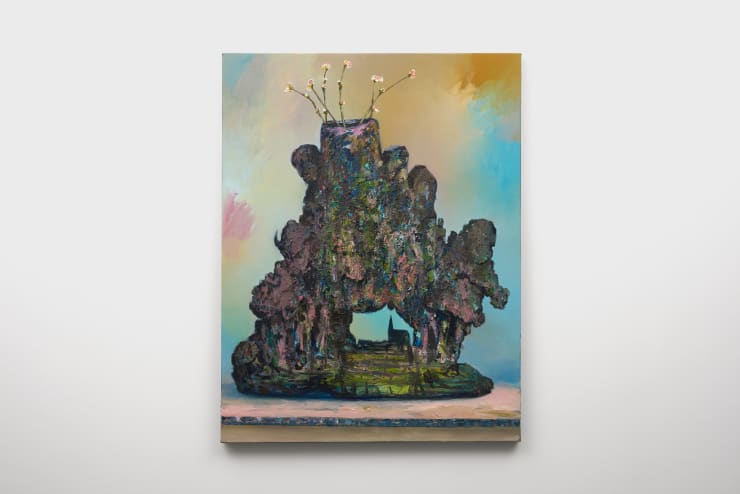Ivan Seal: Grottoesque
Past exhibition
-
OverviewAlma Pearl is pleased to present Grottoesque, a solo exhibition of new paintings and a sound installation by Ivan Seal, on view from 12 September to 25 October 2025 in London. A sound piece by The Caretaker will also accompany the exhibition. This presentation marks the second chapter of Seal’s two-part project at the gallery and coincides with the recent acquisition of a series of his work by the PODO Museum in South Korea.Taking its title from a portmanteau of “grotto” and “grotesque,” the word Grottoesque conjures an imaginary shaped by the artifice of ornamental caves and the lingering psychological residue of excess.1 Emerging during the Renaissance, grottoes functioned as sites of aesthetic fantasy and philosophical experimentation—spaces where classical mythology, Arcadian dreams, and esoteric speculation coalesced. Following prelude, which evoked a candlelit grotto, Seal draws on this cultural and historical context to construct an interior landscape—darkly opulent and unsettlingly distorted.The result is a warped chamber of curiosities, where boundaries between nature and artifice dissolve into hallucinatory collapse. Suggesting a dialogue with our culture’s preoccupation with digitally contoured perfection, Grottoesque reclaims the image as a site of disruption, marked by glitches, aberrations, and mutations.Across these canvases, familiar motifs undergo painterly transformation. Architectural forms—church spires and chapels—bloom improbably from domestic vessels, while crystalline structures give way to pastoral hallucinations. Floral-adorned vases teeter on the verge of collapse, suspended between the ornamental and the ominous.Drawing from postwar domestic décor as well as the history of landscape painting, these compositions evoke a distinctly British vernacular, which references kitsch and nostalgia. In Ivan Seal’s hands, this imagery becomes a charged site of contradiction—both alluring and unsettling, simultaneously familiar and alien.Seal embraces the deformed, the excessive, and the uncanny: his figures slither and contort, folding into themselves. Like relics from a corrupted archive, the surfaces of his paintings pulse with psychological entropy—part flesh, part ornament, part non-being. This tension finds aural expression in Divination Set (2025), Seal’s new sound work, which reconfigures the 5D-ASC (Five-Dimensional Altered States of Consciousness) questionnaire—a scientific tool designed to measure the subjective intensity of psychedelic experience. In this piece, Seal transforms his voice, replacing the singular “I” with the collective “we,” creating a choral reading that evokes a reality both dystopian and utopian.To mark the occasion of this exhibition, a limited-edition 10" vinyl record will be produced and launched during Frieze Week. The record will feature the spoken word pieces created for this two-part exhibition: Entitlement of Youth–shown in prelude–and Divination Set (both 2025).Ivan Seal (b. 1973, Stockport, United Kingdom) lives and works in Berlin. Recent exhibitions include Perhaps Sunny Days, PODO Museum, Seogwipo, South Korea (2024); against the day after before, The Hole, New York (2024); Polireality, Hive Center for Contemporary Art, Beijing, China (2023); Positions, Alma Pearl, London (2023); Today Rots Through Tomorrow, Richard Heller Gallery, Los Angeles (2022); Three Rooms, Carl Freedman Gallery, Margate, UK (2021) and IVAN SEAL + THE CARETAKER: everywhere, an empty bliss, FRAC Auvergne, Clermont-Ferrand, France (2019). Seal is also well-known for creating the album cover for longtime collaborator, The Caretaker, with whom he has also exhibited and performed visuals internationally, from the Barbican in London to the Lincoln Center in New York. Ivan Seal’s work in included in the collections of the PODO Museum, Seogwipo, South Korea; Government Art Collection, London, UK; Norwich Castle Museum, Norwich, UK; Kistefos Collection, Jevnaker, Norway; and the Frac Auvergne, Clermont-Ferrand, among many others.1. The word "grotesque" originates from Italian, specifically from the term "grottesca" (also "opera grottesca" or "pittura grottesca"), which referred to the decorative paintings found in ancient Roman caves (or "grotte") during Renaissance excavations. These paintings, often featuring fantastical and bizarre combinations of human and animal forms, were a novelty at the time, leading to the term's adoption into other languages.
-
Installation Shots
-
Works
-
Publications








